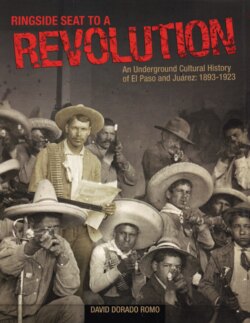Читать книгу Ringside Seat to a Revolution - David Dorado Romo - Страница 10
На сайте Литреса книга снята с продажи.
Оглавлениеhad a lot to do with me coming back, of course. But
there was something else. If geography is destiny, as
they say, then I felt I had to come to terms with my
own geography.
THE FIRST RULE of psychogeography is to walk
through the streets without preconceived notions; just
drift and let the city’s underground currents take you
where they will. The areas that drew me the most at
first were the Tex-Mex dives along Alameda Avenue,
neglected cemeteries, the Santa Fe International
Bridge, the seedy hangouts on Avenida Juárez and
those same old buildings around downtown El Paso
that had first pushed me away. I took a notebook to
jot my impressions down. Sometimes I’d take a cam-
era as well.
During one of my walks, I was writing in my
notebook by the barbed-wire fence near the Santa Fe
Bridge when I was stopped by a security guard. He
asked me what I was doing. I wasn’t sure how to
explain that I was making a psychogeographical map.
I refused to show my I.D. to the security guard
even though he threatened to call the police. I figured
if jail was the next stop on my psychogeographical
tour, so be it. But the guard warned me that taking
notes in the middle of the street near an international
crossing looked suspicious and let it go at that. (This
was before Osama bin Laden’s attack on New York.)
A few days later my investigation took me to a
zone in Juárez along Mariscal and Ugarte Streets. It’s
a tough part of town. During the revolution, it was
called Calle del Diablo. When Francisco Madero’s
troops rode into Juárez triumphantly on May 10, 1911,
the prostitutes from this part of town followed
behind, cheering the men wildly. Later, Prohibition
4
